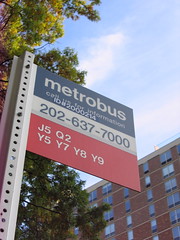 Crossposted at Greater Greater Washington
Crossposted at Greater Greater WashingtonTaking the bus in Washington often requires quite a lot of patience. With stops one some segments at every corner, buses seem to take an eternity to go only a few blocks. Removing some stops could improve travel times without negatively impacting ridership.
Closely spaced stops reduce the efficency of bus lines. If the number of riders stayed the same, a bus line with fewer stops would have similar boarding/alighting times, but would save time in accellerating, decellerating, and entering or leaving traffic. Less time would be spent at traffic signals when the bus missed the green in order to pick up passengers. Savings would also be realized in the time for the bus to accommodate the elderly or infirm using the kneeling feature or the wheelchair ramp.
Of course, on the other hand, reducing the number of stops would increase the distance that some riders have to walk to get to the stop. Would a few hundered feet worth of difference deter bus riders? Perhaps, but it would be less likley to do so if there was a net gain in time savings.
And time saved is money saved. Reducing the run time of buses means that the transit agency does not need to run as many buses to maintain the same headway. Alternatively, the same number of buses could run at a higher frequency for the same cost. There are major benefits to improving bus performance, including providing a relief valve for Metrorail.
As a former daily rider of the 50s Line along 14th Street in Northwest and Southwest DC, I am intimately familiar with the stop frequency for buses. In fact, from my stop at 14th and Shepherd, the next bus stop to the south was only about 375 feet away at Randolph Street.
In fact, for the segment of the 50s Line between the downtown split of the 52 and 54 to the Colorado Avenue Terminal, where most buses turn back, the average distance between stops is 623 feet. For reference, the length of a Metro platform is 600 feet. A railcar is 75 feet long. That means that on average, between stops, the 14th Street bus line travels, on average, barely more than the length of an 8-car train. Passengers at Gallery Place walking from the Green/Yellow level to the 9th & G Entrance walk further than that within the station.
Breaking down the 52, 53, and 54, by segment, we can note the following average distance between stops:
- Downtown Segment, 52 Southbound: 837 feet.
- Downtown Segment, 52 Northbound: 855 feet
- Downtown Segment, 54 Northbound: 784 feet
- Combined 52, 54, New York Ave to Colorado Ave Northbound: 633 feet
- Combined 52, 54, Colorado Ave to New York Ave Southbound: 611 feet
- Combined 52, 54, Colorado Ave to Takoma Station Northbound: 648 feet
- Combined 52, 54, Takoma Station to Colorado Ave Southbound: 735 feet
Of course, it is vital that bus stops be accessible to the most people, but one wonders where to draw the line. After all, people often walk some quite a good distance to get to quality transit. If buses got people to work or to the store more quickly, they would probably be willing to walk further.
A policy of increasing the distance between stops to at least two or three blocks apart would be a good place to start. Especially in walkable neighborhoods. With stops 3 blocks apart, once you reached the street on which the bus ran, you'd never be more than one block from a stop.
So far, Metro's solution to this has been to implement limited stop services like the S9 on Sixteenth Street and the 79 on Georgia Avenue. In the case of 16th Street, the S9 makes only 14 stops between Silver Spring and McPherson Square, with an average distance between stops of 2,678 feet. With fewer stops, the 16th Street Express is competitive with the rail system. According to Metro's trip planner, a trip from Silver Spring to McPherson Square takes about 27 minutes by rail and about 36 minutes with the S9.
But why should riders have to wait for a new service before trip times improve? Why not reduce the number of stops overall? Perhaps the "local" stop buses needn't have 2,600 feet between stops, but 1,000 certainly sounds like a better number.
The Manual on Uniform Traffic Control Devices suggests that the average person walks 4 feet per second. Other studies show that the elderly make around 3 feet each second when on foot. Increasing the average stop spacing on the 50s line from 623 feet to 1000 feet would increase the average distance between stops by 377 feet, which could be covered by someone walking at 3 feet per second in a little over two minutes.
Limited stop buses are certainly a positve aspect to our transit system. And I hope that WMATA is able to implement more of them. However, reducing travel times on all routes should be a priority.
In fact, WMATA is currently working on a set of bus stop optimization criteria. One of the factors is bus stop spacing. According to a report given to the Riders Advisory Council earlier this month, Metro reports that other transit systems, like Seattle's King County Metro, have found a good balance between access and efficiency at 4-5 stops per mile, which is a little over 1000 feet apart. Right now, WMATA has 63 bus routes with stop spacing exceeding 5 stops per mile.
WMATA's proposed bus stop standards would help create uniformity and ensure safe, accessible stop design across the region. It would serve as a guide for jurisdictions in the region when considering bus stops.
Commenting on this post has been disabled. Please continue the discussion on this same post at Greater Greater Washington.









